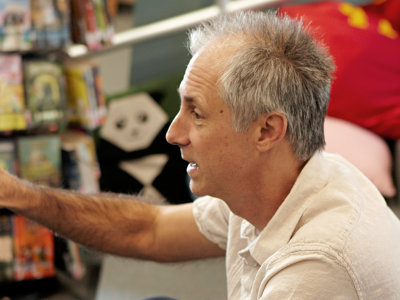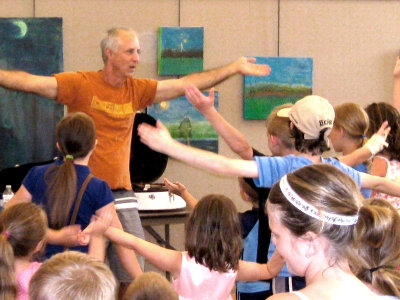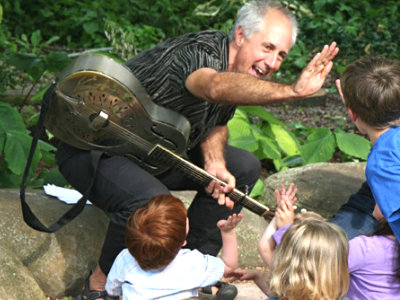
A Conversation With Stuart Stotts
by Carole Stephens
Stuart Stotts comes with a long list of titles: songwriter, musician, singer, storyteller, author, teaching artist, educational trainer, and historian. That’s what has made getting to know him so intriguing over the past twenty years! Yes, there were still surprises as we talked, for example: “in third grade, when I lived in Chicago, my parents got a guitar at a pawn shop and I took lessons. We had this little paperback book that had folk songs in it—put out by a cigarette company! It was the kind of time that people sat around singing folk songs together.” So began the many musical adventures of CMN’s 2015 Keynote presenter.
There was a year abroad in England where Stuart played church Easter breakfasts (“Mary Don’t You Weep”) and wrote lyrics to The Who’s songs, “typical teenage angst about how the rest of the world sucked.” A post-college winter solo hibernation on his parent’s “little piece of land” in Wisconsin was where writing folk songs really began.
What happened once you found your songwriting voice?
I moved into Madison after that. I was very politically involved, and I wanted to play at rallies and meetings to inspire people and move them forward. I wrote “World Citizen” then. Then in 1986 friends said to me, “Stuart, you should try schools—you might like it!” I was working as a case manager for developmentally disabled people—and I just said, “I’m going to do music,” and never really looked back!
The focus of your music at that time was to make kids think, or entertainment, or how to be a better person?
It always had a purpose. It was never just “hey, we’re gonna sing some songs.” This was in the late eighties, Reagan was president, and people were really into the peace movement. One of the first kids’ songs I knew was “Under One Sky” by Ruth Pelham. I started to learn about what worked with kids, and I also met Tom Pease. Tom was like a mind-blower in terms of what he does with kids. Everybody else I knew just got up there and sang and encouraged kids to sing along. But there’s no one like Tom! And I thought, “Maybe I should rethink what I’m doing!”
Is that where the partnership started?
Tom and I have been working consistently together since the late nineties. We do maybe twenty-five days a year of residencies. Those first ten or fifteen years I wrote a lot of songs with kids. I could go into a room with kids and come out an hour or two later with authentically written songs that were new. I really wanted it to come from kids. I think some songwriters with kids are doing more of the process than I would want to. The songs are better than third graders can write. That’s okay, but it was really important to me that we really grappled with it together.
So your focus was not as much performance?
Oh, no. I did a lot of assemblies…but up here in Wisconsin, the assembly is a dying art form. If I were starting out right now, I don’t think I could do it. I work with teaching artists sometimes, and I want to say, “What the hell are you doing—there’s no work!”
You’ve been versatile and adaptive enough to say this is my skill set and this is where it fits with what people need. I’ve seen a definite shift in your focus—and I don’t know how much of that is the Kennedy Center focusing what you do or evolution?

I think it’s both. One of my skills is writing songs with kids. I’m also dedicated to storytelling because I love the focus and engagement that comes when kids tell stories. There’s a part of me that wishes that some school district would just hire me to be the district storyteller. I’d just go around from class to class and tell stories, because kids love them and they need them, and they don’t get them.
On your website there’s one phrase that jumped out at me: “We are wired to hear stories.” What does that mean?
When someone starts telling a story, our brains literally go into a different state. You can see it! The first time I told a story, I looked out and there were 250 kindergarten to second graders, and they’re completely silent and focused. Even at its best, doing music you don’t get that kind of focus and engagement. Our brains just naturally go to that during a story. It’s the most powerful incentive, once you get past food and shelter. It’s like BAM with story! I love it, and I love that for kids—despite all the high tech—the power of sitting in a circle and hearing a ten-minute story about Jaguar and Crab and Oonkaloonka fish—they’re just completely present!
Do you have a theory as to why, for story, the brain can focus with such accuracy when it doesn’t happen in the classroom during a math lesson?
You know oxytocin? It’s the intimacy neurotransmitter. I just read an article by Paul Zak about oxytocin release during narrative encounters. Literally your brain gets a kind of empathy rush as you’re listening to stories. There are many people looking at this that say it’s the ability to look at ourselves (mirror neurons) within a situation. Our brains are firing neurons as if we are in the situation, because over the years this is how we learned. When you hear the story, it shapes how you see the world, how you plan for the future. All the good political candidates, preachers, and teachers know this! And yet we somehow think that if I just lecture you, you’re going to get it. The thing that’s really interesting to me is that when I tell a fifteen-minute story to kids that has no participation in it, they’ll be completely with me. I would never sing a song for kids that has no part for them. I just don’t do it. Whether it’s words or emotions, I assume that whatever I sing, participation will be a part of it.
But not when you’re telling a story?
Nope—it’s a different part of the brain. But the experience of singing together in a group, full-hearted, is an incredible experience. It’s in a different realm than listening to a story. You’re just singing together and the song is filling up your heart. That is the other thing that I want people to get. No one ever gets to sing together in that way in our culture.
I’ve got it down to two times that we sing together in community—in church and at a baseball game for the seventh inning stretch. It’s not gonna happen otherwise! I think it’s about the creation of community.
That’s exactly what I’m talking about, Carole. There’s this incredible thing that happens. Lately I’ve been into going to gospel churches. I’ve had these experiences—I’m not singing necessarily, but it’s this feeling of being filled up with music. At that point it’s not about the words. I don’t really think people get a message from songs anywhere near the power of the experience of the singing.
 (photo by Sarah Sprague)
(photo by Sarah Sprague)
It’s been my experience that parents now don’t know how to sing in public. They grew up with the music of the eighties and nineties, which was not exactly group sing-alongs: rap and hip-hop, and you didn’t sing disco in the shower!
This idea of singing together has become a little niche thing, and that we’re carrying the torch for the culture as a whole is overwhelming. The culture says, “We will sell you the music you will listen to,” and you might sing along…but it is not a live thing. On my blog there’s a song, “Lou is a teacher, he’s doing his best in an era of high-pressure, standardized tests,” but at the end of the day he turns off his iPod and sings with his kids. Lou’s a real person, and I love that!
What do you do with the Kennedy Center?
The Kennedy Center is trying to save the arts in schools because so many schools have such little artistic exposure for kids. The Kennedy Center asked, “What can we do to contribute to the sense of equity for arts with kids? We can’t fund arts teachers for every school, but what we can do is offer workshops for teachers that will connect to the standards that they have to address, and will use the arts to do that.” You can’t teach somebody how to write a song in two hours, but you can teach what you can realistically expect they will use next Monday morning, based on really good educational practice.
Your focus is the musical component?
Music and story.
Together or separately?
Separately. The Kennedy Center gives me two things. The Artist Retreat is a fantastic thing. I’m on the younger end of the artists who are there, which tells you something! It’s all people who have been working with kids for thirty or forty years. They’re very smart and very knowledgeable about what it means to be in a classroom, in a school, dealing with standards. They understand assessment. But they’re also artists. I love the organizers because they’re constantly challenging the artists to get better in a way that’s more than just “I’ll do another assembly program.” Then you go out to Kennedy Center partners all over the country and do workshops, which might also include demonstration teaching or working with local teaching artists. One of my workshops is “Lyric Writing and Bullying.” How can you use lyric writing to address bullying in a school? Missoula, Montana may say, “Well, that looks good,” and they’ll fly me out there for a workshop and maybe I’ll do something in a classroom, too, and then I’ll fly home. I do between ten and twenty-five days like that a year.
What’s the next segment of the Stuart Stotts pie chart?
I do schools—maybe twenty-five days per year of residencies. Some of those will be with Tom—I don’t do that many by myself anymore. They’re multiple day. We’re actually trying to create something while we’re there. I’ll do performances. This summer I had maybe forty-five libraries. Then I’ll do some early childhood trainings.
No birthday parties, eh?
No birthday parties! I mean, I’m okay at that, but as you know, you get in some situations where you can’t do what you want to do!
It can be unpleasant.
Lately I’ve been working in international schools, and I love doing that. I’m going to Bucharest next!
I’m so jealous! Is that on your own?
Yes. The other thing I do is I’m working on this online education system for early childhood providers and teachers. We’re hoping to debut it this fall. We’ve been working on it for years—it keeps chugging along.
So do you write your books between midnight and 7:00 a.m.?
Yeah! Right now I’m working on a book, Beyond Nice: 131 Ways to Nurture Kindness in Young Children. It’s almost done. I started it a year and a half ago.
Is this a children’s book?
It’s a book for teachers and parents. So there are twenty chapters and each chapter has a theme. One of the chapters is obviously Music—how you can nurture kindness through music! Another is Story. Then there’s Nature and Outdoors, Gratitude, Mindfullness…. There are all these different activities, hands-on things, that teachers can do with the focus being on nurturing kindness.
Did the song you shared in this issue of PIO! come out of your recent trip to Tanzania?
Yes. I was so affected by seeing these animals and thinking about them being threatened! Could there really be a world without rhinoceroses in five years? In Africa, there’s something that gets inside you. That’s where we came from! “Serengeti Plain” was inspired by this trip. It’s not a heavy song, “We must stop the slaughter! Children—sing along!” It’s more about who these animals are, and being grateful for them.
So looking back from the past to now, is there a point at which you thought, “I think this is going to work!”
I’m still waiting for that moment! I look ahead and wonder, “Am I going to be okay this year?” I don’t take it for granted. So I diversify…I like doing a lot of different stuff.
Does Stuart Stotts retire?
Stuart Stotts works less. Yeah.
But musicians don’t retire?
Could you really afford to do nothing? I think you do less—less of what you don’t like, and there isn’t very much that I don’t like, but there are some things I like more than others!
Stuart, what’s still on your bucket list?
I want to go to India! And…I think every songwriter has the idea that they’d like to have a song that would spread far and wide. “Music in My Mother’s House,” frankly, has done that in a certain way. But it would be cool to have another song that wouldn’t be just about me singing it—a song that somehow had a life of its own.
About that song—was your family musical?
Not really. My mom played some piano, but we didn’t really—that whole “music in my mother’s house” thing isn’t really about my family.
Final thoughts?
Wouldn’t it be cool to be that travelling minstrel with a banjo and all I know about kids, and just sing with them. You could never make a living singing for kids in Africa—$8 a day is the national wage—but it was so joyful! It was like music really is this language that transcends everything else. I would love to have more experiences like that: Hey, we’re just singing!
You can sing with Stuart Stotts at the Children’s Music Network International Conference in Zion, IL, October 16–18, 2015.